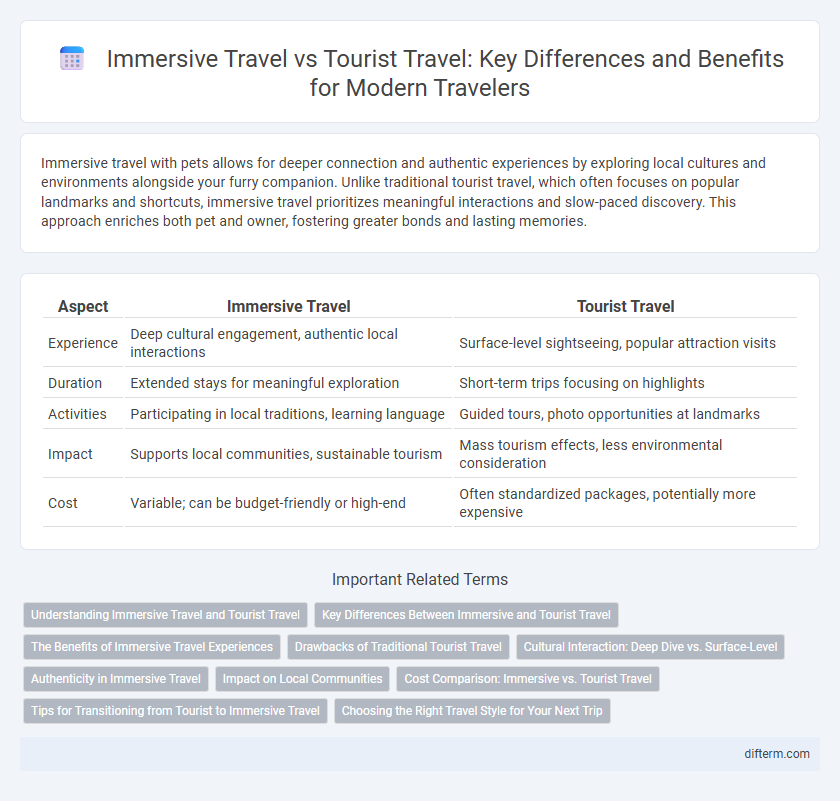Immersive travel with pets allows for deeper connection and authentic experiences by exploring local cultures and environments alongside your furry companion. Unlike traditional tourist travel, which often focuses on popular landmarks and shortcuts, immersive travel prioritizes meaningful interactions and slow-paced discovery. This approach enriches both pet and owner, fostering greater bonds and lasting memories.
Table of Comparison
| Aspect | Immersive Travel | Tourist Travel |
|---|---|---|
| Experience | Deep cultural engagement, authentic local interactions | Surface-level sightseeing, popular attraction visits |
| Duration | Extended stays for meaningful exploration | Short-term trips focusing on highlights |
| Activities | Participating in local traditions, learning language | Guided tours, photo opportunities at landmarks |
| Impact | Supports local communities, sustainable tourism | Mass tourism effects, less environmental consideration |
| Cost | Variable; can be budget-friendly or high-end | Often standardized packages, potentially more expensive |
Understanding Immersive Travel and Tourist Travel
Immersive travel emphasizes deep cultural engagement through local experiences, such as homestays, traditional cooking classes, and community participation, fostering authentic connections and personal growth. Tourist travel typically involves visiting popular landmarks and attractions, prioritizing convenience and sightseeing over cultural integration. Understanding these differences helps travelers choose experiences that align with their desire for meaningful exploration or recreational leisure.
Key Differences Between Immersive and Tourist Travel
Immersive travel emphasizes deep cultural engagement, local experiences, and meaningful interactions with communities, contrasting with tourist travel, which often focuses on visiting popular landmarks and sightseeing. Immersive travelers seek authentic experiences through activities like homestays, local cuisine, and participation in traditional events, whereas tourists typically rely on guided tours and standardized attractions. The key difference lies in the level of personal involvement and cultural understanding achieved during the journey.
The Benefits of Immersive Travel Experiences
Immersive travel experiences foster deeper cultural understanding by encouraging interaction with local communities and firsthand participation in traditions, enhancing personal growth and empathy. Unlike conventional tourist travel, immersive travel often leads to unique, memorable moments that promote sustainable tourism and support local economies. These experiences enrich travelers' perspectives, making trips more meaningful and transformative.
Drawbacks of Traditional Tourist Travel
Traditional tourist travel often results in superficial experiences, limiting meaningful engagement with local cultures and communities. It can contribute to overcrowding at popular destinations, causing environmental degradation and diminishing the quality of visits. Furthermore, tourist travel frequently supports mass-market businesses rather than local economies, reducing authentic cultural exchanges and economic benefits for residents.
Cultural Interaction: Deep Dive vs. Surface-Level
Immersive travel emphasizes authentic cultural interaction through living with local communities, participating in traditional rituals, and learning native languages, enabling a deep understanding of customs and values. Tourist travel often remains surface-level, confined to popular landmarks and guided tours that offer limited engagement with the local culture. This profound vs. superficial cultural exposure significantly shapes the traveler's experience and connection to the destination.
Authenticity in Immersive Travel
Immersive travel emphasizes authentic experiences by engaging travelers in local culture, traditions, and daily life, distinguishing it from conventional tourist travel that often prioritizes popular attractions and superficial encounters. Authenticity in immersive travel fosters deeper connections with communities, facilitating meaningful interactions and genuine understanding of a destination's heritage. This approach enhances cultural appreciation and transforms travel into a more enriching and memorable journey.
Impact on Local Communities
Immersive travel fosters meaningful connections by encouraging visitors to engage with local traditions, support small businesses, and prioritize sustainable practices, which helps preserve cultural heritage and boosts community economies. Tourist travel often leads to overcrowding and resource strain, diminishing the quality of life for residents and causing environmental degradation. Emphasizing immersive experiences promotes respectful interaction that benefits both travelers and local populations by enhancing mutual understanding and long-term economic stability.
Cost Comparison: Immersive vs. Tourist Travel
Immersive travel often offers cost savings through local accommodations, street food, and public transportation compared to tourist travel's reliance on hotels, guided tours, and dining at popular attractions. Tourist travel typically incurs higher expenses due to premium pricing for convenience, safety, and curated experiences, while immersive travel prioritizes authentic interactions and budget-friendly options. Choosing immersive travel can reduce overall trip costs by up to 30-50% while enriching cultural understanding and personal connection.
Tips for Transitioning from Tourist to Immersive Travel
Embrace local customs and engage deeply with community traditions to shift from tourist to immersive travel, enhancing cultural understanding and authentic experiences. Opt for homestays or locally-run accommodations instead of standard hotels to foster genuine connections and support regional economies. Learn basic phrases in the native language, which facilitates meaningful interactions and enriches your travel journey.
Choosing the Right Travel Style for Your Next Trip
Immersive travel prioritizes deep cultural engagement, local experiences, and meaningful interactions, contrasting with tourist travel that often focuses on popular attractions and convenience. Selecting the right travel style depends on your goals, whether you seek authentic connections and personal growth or efficient sightseeing and comfort. Understanding these distinctions helps tailor your itinerary for maximum satisfaction and memorable experiences.
immersive travel vs tourist travel Infographic

 difterm.com
difterm.com